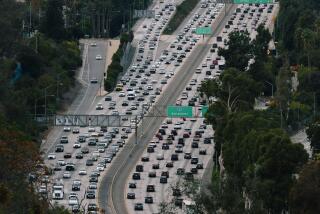Editorial: Carpoolers, meet the (hopefully less congested) 405
- Share via
And so, after four years and more than a billion dollars of work on the 405 Freeway, after marathon weekend closures of lanes (Carmageddons I and II and Jamzilla), after obstacle courses of orange cones and K-rails, after widening three bridges and carving into the side of a canyon, the newly expanded carpool lane will debut Friday morning. There will now be one contiguous high-occupancy vehicle lane on the northbound 405 from Orange County to the 5 Freeway. Combined with the existing southbound HOV lane, the 405 Freeway will have the two longest continuous carpool lanes on the planet. Well, in the nation, for sure.
The good news is that Metro is ahead of schedule; earlier this year officials predicted the carpool lane wouldn’t be completed until summer. The bad news is that, alas, the job is not entirely finished. Crews will still be doing landscaping, electrical work and, yes, intermittently closing lanes and ramps. Metro and the contractor — Kiewit — should keep in mind that everyone who travels the 405 is suffering construction fatigue and anything that closes a lane or a ramp is one more inconvenience in a four-year series of them. They should work on getting out of the Sepulveda Pass, like, yesterday.
Still, the main purpose of this project was to create a new lane of traffic on the 405 between the Santa Monica and Ventura freeways and turn the far left lane into a carpool-only lane. That’s done. So now comes the real test: Will traffic be less congested?
In some ways, traffic flow has already improved. Some onramps and offramps were widened and lengthened and untangled. So there are fewer cars backed up on surface streets to get onto the freeway and fewer cars queued up on the freeway to exit it.
Caltrans estimates that carpoolers save one minute per mile in the HOV lane during peak hours. Since the project just added 10 more miles of HOV lane, that alone should save carpoolers 10 minutes. In addition, carpoolers moving to the HOV lane improve the flow of traffic in the remaining lanes.
Others argue that the freeway, with its increased capacity, will simply attract more drivers who would otherwise take surface streets or stay home or take a bus, and that many of them might not be ride-sharers. That doesn’t mean the project was pointless; there is a value to providing more options for more people who need to get to schools, jobs, doctors’ appointments.
But there is a finite amount of widening that the freeways and the region can sustain. In the long run, the better way to cope with increasing traffic — and the environmental problems caused by fuel emissions — is to get more people out of their cars. That’s a matter of improving public transit and creating incentives for people to use it. The day a subway train spans the length of the 405 will be the day people get off the 405.
More to Read
A cure for the common opinion
Get thought-provoking perspectives with our weekly newsletter.
You may occasionally receive promotional content from the Los Angeles Times.










